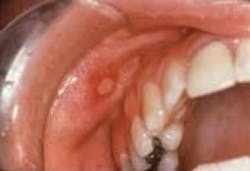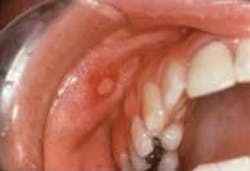Recurrent aphthous stomatitis
Appropriate treatment depends on systemic involvement
by JoAnn R. Gurenlian, RDH, PhD
Those pesky, painful canker sores that sometimes occur can drive patients to your practice, concerned that they have oral cancer. These benign lesions have a tendency to recur and are the most painful ulcer of the oral cavity for their size.
Recurrent aphthous stomatitis (RAS) are painful lesions that occur within the oral cavity. There are three general forms of RAS: minor, major, and herpetiform. All are considered to be part of the same disease spectrum. Differences tend to be clinical in nature and correspond with the degree of severity.
Figure 1: Minor RAS. Courtesy of Discus Dental, LLC.
Minor RAS may present as single or multiple lesions. They appear with acute onset and generally are less than 0.5 cm in diameter (see Figure 1). The ulcer is covered by a yellow fibrinous membrane and surrounded by an erythematous halo. Major aphthous lesions are less common, but these ulcers can be greater than 1 cm in diameter and considerably more painful. Clinically, major and minor RAS can both appear crateriform. The herpetiform type of RAS presents as multiple small ulcers that tend to coalesce. Unlike herpes infections, these ulcers are not preceded by vesicles and do not demonstrate virus-infected cells.
The etiology for RAS remains unknown; however, various local, systemic, immunologic, microbiologic, nutritional, and genetic factors have been proposed. Stress may also be a predisposing agent. Activation of cell-mediated immune response (CD8+) appears to be a common primary finding. The differential diagnosis for RAS includes secondary oral herpes, trauma, Behcet’s syndrome, Reiter’s syndrome, Crohn’s disease, erythema multiforme, pemphigus vulgaris, and neutropenia. It is helpful to note whether the ulcers occur anywhere else in the body or if there are intestinal symptoms associated with the ulcerative condition. Distinguishing RAS from recurrent oral herpes can be done based on the history of vesicles preceding ulcers, location of lesions (herpes may present both extraorally and intraorally), and laboratory studies to identify HSV.
Typically, laboratory tests or biopsies are not indicated for the diagnosis of RAS. The diagnosis is often based on the clinical presentation, signs and symptoms, the recurrent nature of the problem, and the rate of healing.
There is no cure for RAS. Appropriate treatment depends on the degree of systemic involvement, severity of symptoms, and duration. Patients with systemic diseases and nutritional deficiencies should be referred to appropriate health-care specialists. For minor RAS, topical application of 5% amlexanox oral paste (Aphthasol) has been shown to increase the healing rate and provide greater pain relief. In general, minor RAS lesions will heal in seven to 10 days without scarring. Recurrences vary and are individually based. For those patients who present with major and herpetiform RAS, local and/or systemic corticosteroids, antibiotics, antiviral, and oral suspensions of tetracycline or nystatin have been recommended. In some cases, laser surgery is used. Major RAS lesions may take six weeks or more to resolve, heal with scarring, and recurrences are more frequent than minor aphthous ulcers. Healing for herpetiform RAS takes place within seven to 10 days.
JoAnn R. Gurenlian, RDH, PhD, is president of Gurenlian & Associates, and provides consulting services and continuing-education programs to health-care providers. She is a visiting scholar at Capella University and vice president of the International Federation of Dental Hygienists.

